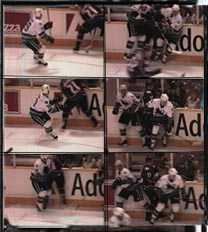
Ice Hockey
Ice hockey is definitely the most brutal form of hockey. Many violent collisions, fights, and bodychecks occur during every game. That is why it is perfectly appropriate to demonstrate the rules of momentum, impulse, and collisions using examples from ice hockey.

To successfully understand how momentum and impulse apply to ice hockey, it really helps to have a strong understanding of what they are. Momentum is defined as the MASS of an object times its VELOCITY, or P=mv. Impulse is known as simply the change of momentum, and is formally defined as the product of the force exerted to change the momentum and the time it took to do that (I=Ft).
| P=mv I=Ft |
Lets say a 5’3" 50 kg. right wing skates at 7 m/s. If a 6’2" 85 kg. defenseman skates at the same rate, who has the greater momentum? How much greater?
OBSERVE:
P=(50 kg.)(7 m/s) P=(85 kg.)(7 m/s) = 350 kg.m/s = 595 kg.m/s |
The defenseman has a significantly larger momentum than the right wing. The difference is 245 kilogram meter per seconds.
PROBLEM #2:
If the same 6’2" 85 kg. defenseman gets angry with you (watch out!), and decides to exert a 600 N (Newton) force by punching you in the face, and exerts this force for .9 seconds, what is your change in momentum? (HINT: this is the same as the impulse you are exhibiting).
OBSERVE:
I=(600 N)(.9 sec.)
= 540 kg.m/s
Click here calculate the force of a moving player on-line!

There are two extremities in types of collisions: totally elastic and totally inelastic. Both of these types of collisions can be frequently observed while watching your typical NHL ice hockey game.
Here is an example of a near totally elastic collision; after hitting each other, both players bounce off each other like rubber balls, and almost no kinetic energy is lost.

 |
In this photo, after colliding with each other, the two players almost become one, and have lost virtually all of their kinetic energy. They probably saw each other in just enough time to latch on to the other one, and therefore are a prime example of an almost totally inelastic collision. |